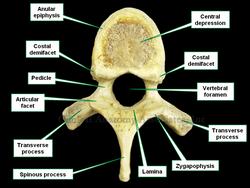This article is part of the series "A Moment in History" where we honor those who have contributed to the growth of medical knowledge in the areas of anatomy, medicine, surgery, and medical research.

Insert text here
Giovanni Domenico Santorini (1681 – 1737). Italian anatomist, Santorini was born in 1681 in Venice. The son of an apothecary, Santorini studied medicine at Bologna and Padua, receiving his doctorate in Pisa in 1701. He was appointed Public Professor of Anatomy at the Physicomedical College of Medicine when he was 22 years of age.
Santorini was praised for the clarity of his lectures and his dexterity as an anatomist. He used magnifying glasses to study minute anatomical details, allowing him to clearly describe small structures hitherto unknown. Most of Santorini’s biographical data was written by Michael Girardi (1731 – 1797), one of his students. Girardi published Santorini’s work posthumously in 1775 in the book “Anatomici Summi-Septendecim Tabulae”.
Santorini’s himself wrote “Opuscula medica de structura” (Minute Medical Structures) in 1705. His most important book was “Observationes anatomicae”, published in Venice in 1724. One of the most interesting chapters in this book was “De mulierum partis procreationes datis” (Data on the female procreational structures ), making him a pioneer in the teaching of obstetrics. Santorini was physician to the Spedaletto (Hospital) of Venice, where he taught midwifery.
Santorini died in 1737 because of an infection he acquired during the dissection of a cadaver. At that time the rationale for infection and cadaver embalming were unknown.
With his posthumous publications, Santorini’s name and teachings became popular. Today his name is eponymically tied to several structures in the human body:
• Duct of Santorini: An accessory pancreatic duct that opens into a secondary duodenal papilla in the second portion of the duodenum
• Santorini’s valves: Mucosal folds found in the lumen of the primary duodenal papilla (of Vater) or hepatopancretic ampulla
• Santorini’s muscle: Risorius muscle • Santorini’s cartilages: The laryngeal corniculate cartilages
• Santorini’s veins: A plexus of vesicoprostatic veins found in the retropubic space) of Retzius
• Santorini’s concha: The superior nasal turbinate
Sources:
1. “The Dorsal Venous Complex: Dorsal Venous or Dorsal Vasculature Complex? Santorini’s Plexus revisited” Power NE, et al. BJU Inter (2011) 108: 930-932
2. “Giovanni Domenico Santorini: Santorini’s Duct” Edmonson, JM Gastrointest Endosc (2001) 53:6; 25A
3. "Santorini of the duct of Santorini" Haubrich, WS Gastroenterol 120:4, 805
4. “Wirsung and Santorini: The Men Behind the Ducts” Flati, G; Andren-Sandberg, A. Pancreatology (2002)2:4-11
5. "A Historical Perspective: Infection from Cadaveric Dissection from the 18th to the 20th Centuries" Shoja, MM et al. Clin Anat (2013) 26:154-160






